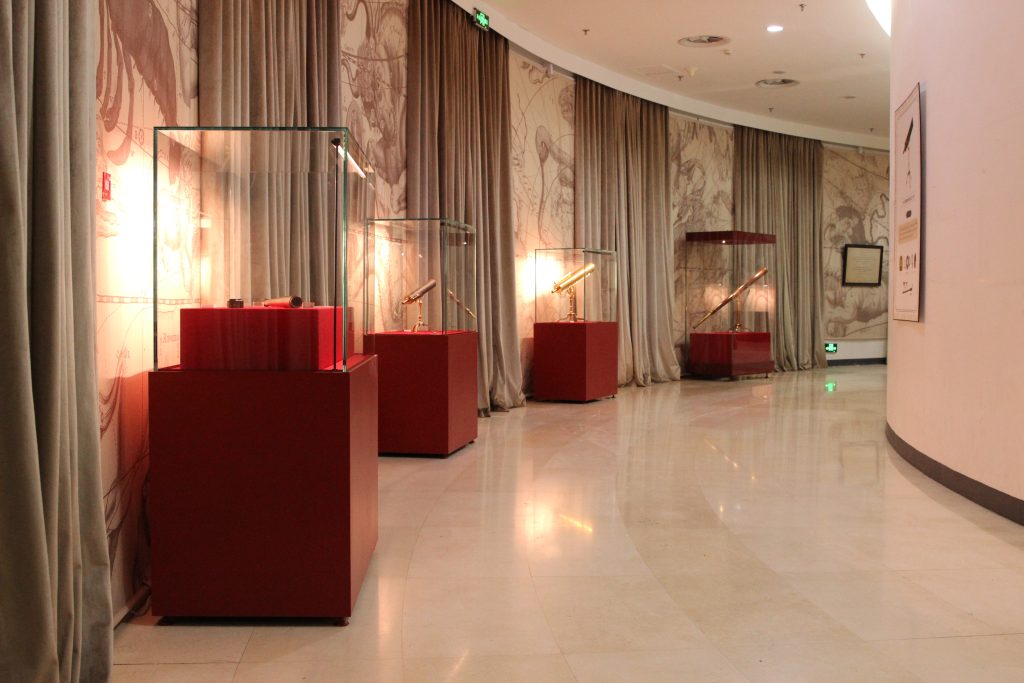On the auspicious date of September 23rd, 2020, the Beijing Planetarium unveiled its latest exhibition, “Peering into the Cosmos – An Antique Telescope Exhibition,” along the celestial gallery corridor. Organized by the prestigious Beijing Planetarium, this exhibition showcases eight authentic optical telescopes, meticulously selected from its esteemed collection, hailing from the pioneering eras of the 18th and 19th centuries. Crafted by scientists and manufacturers from the United Kingdom, France, Germany, and Japan, these telescopes embody the pinnacle of technological prowess during the nascent stages of optical telescope development. Comprising one handheld, one floor-standing, and six tabletop models, the collection includes four refractors and four reflectors, offering a glimpse into the remarkable ingenuity of their time.

In addition to these historical instruments, the exhibition also presents 13 astronomically significant paintings, such as “Galileo Displaying His Self-Made Refracting Telescope,” “Scheiner Observing Sunspots with a Keplerian Telescope,” and “Hevelius Conducting Astronomical Observations with His 46-Meter-Long Refractor.” These visual narratives enrich visitors’ understanding of the evolution, innovations, and advancements that shaped the first two centuries of telescope development.
Tools as Extensions of Human Senses
Tools have long served as extensions of our bodily faculties, and the simple pairing of two glass lenses revolutionized the world. In 1609, when Galileo Galilei pointed his self-constructed refracting telescope towards the vast expanse of the night sky, lunar craters, the phases of Venus, and Jupiter’s moons—phenomena once beyond human comprehension—were brought vividly into focus. This marked the dawn of the telescopic era in astronomy, shattering the limitations of naked-eye observation and forever altering our understanding of the cosmos.
A Window to the Universe
The invention of the telescope not only physically opened a portal to the universe but also symbolically ushered in a new era of scientific inquiry. Over the past four centuries, telescopes have evolved from Galileo’s modest 1.5-centimeter instrument to the colossal 1-meter-aperture Yerkes Refractor, 8.2-meter Very Large Telescope, and segmented mirrors spanning tens of meters in diameter. These marvels of engineering have allowed humanity to peer deeper and clearer into the vastness of space, continually pushing the boundaries of our cosmic knowledge. As our horizons expand, so do our perspectives on the universe and our place within it, transforming our universeview and worldview.
Instruments of Truth, Channels to the Cosmos
Telescopes are instruments of truth, bridging the gap between humanity’s insatiable curiosity and the mysteries of the cosmos. At one end lies humanity’s ever-inquisitive gaze, fueled by a relentless thirst for exploration; at the other, an infinite ocean of stars and secrets waiting to be discovered. In this ongoing dialogue with the universe, we not only gain insights into its workings but also gain a clearer understanding of ourselves.
Historic Artifacts, Relics of Progress
Amidst the 80-meter celestial gallery corridor, eight exquisite antique telescopes stand as testaments to history. From the four-section handheld refractor, a contemporary of Newton’s groundbreaking telescope, to the rare eight-section compact refractor with its retractable design; from the black fish-skin-wrapped desktop reflector to the enigmatic brass-bodied reflector adorned with Schott’s signature, each piece tells a unique story of craftsmanship and ingenuity now lost to time. The brass tubes, the warmth of the wooden casings, the personal signatures etched with pride, and the intricate focusing mechanisms—all these elements come together to form a testament to the beauty of science and the profound implications of light and shadow.
















































